-
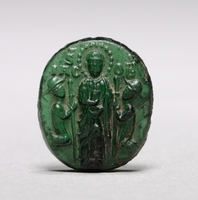 Devotional Badge with Saint James Flanked by Two Kneeling Pilgrims
Devotional Badge with Saint James Flanked by Two Kneeling Pilgrims This green glass souvenir would have belonged to a pilgrim to take with them to remember their pilgrimage to Santiago de Compostela, Spain. There are two pilgrims kneeling next to St. James, also dressed as a pilgrim. The small green sculpture is made of smooth glass, is round in nature, and textured on the front. St. James has a beaded textured halo around his head as he holds the Bible in hand and looks straight ahead. The two kneeling pilgrims are identical on his sides and hold a walking staff, dressed in pilgrims clothing and hat. These figures sit on an even plane with each other and do not create any dimensions or foregrounds with this.
-
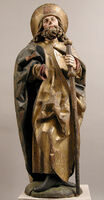 Saint James the Greater
Saint James the Greater The statue of St. James depicts him as a pilgrim, with a sympathetic face and outstretched right arm. He is missing his right hand but wears a pilgrim hat, decorated with an upside down scallop shell on the front, with a walking staff in his left hand, and long pilgrim garbs. The clothing folds and drapes into itself to suggest movement in the material and from the man. The front folds of his garbs are gold with, with blueish green on the back coat, and red wrist coffs. He looks up above the natural line of sight with his chin lifted and tilted slightly to the right side. With a small positive smile, his chin is adorned with a long brown curly beard and brown flowing hair on the side of his face, touching his shoulders.
-
 Puerta de las Platerias
Puerta de las Platerias The southern façade of Santiago de Compostela, known as the Puerta de las Platerias was a common entrance into the cathedral by pilgrims. The design is Romanesque with stone rounded arches that are densely decorated with carved reliefs depicting Biblical characters and stories. The arch is called a tympanum with the round facade and relief worked into its exterior construction. The scene depicts the various duels of Jesus and Satan, where Jesus rebukes him. Angels and demons are scattered intermittently between the scenes, both represented with wings and some demons as monkeys. In entering the cathedral under these two tympanums, a pilgrim could learn about the struggle of good versus evil.
-
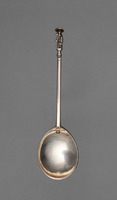 Apostle Spoon: St. James
Apostle Spoon: St. James The spoon's handle has a miniature of St. James, dressed as a pilgrim, with a large oblong pilgrim’s hat, robe, and walking staff. The small object served as a souvenir of completing the Camino de Santiago pilgrimage and a reminder of St. James himself.
-
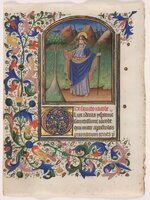 Leaf from a Book of Hours: Saint James the Greater
Leaf from a Book of Hours: Saint James the Greater The page in the Book of Hours depicts St. James as a traditional pilgrim with a staff and scallop shell pilgrim's hat. The manuscript illumination places St. James inside a landscape with a gold leaf and painted floral border. The Latin text adds detail and understanding to the page as well. Since there is an illuminated beginning letter, the “O”, painted with gold leaf and blue and red floral detailing inside of it, and a miniature of St. James, the page represents a title or chapter page for the next section.
-
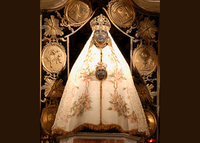 Black Madonna
Black Madonna The Black Madonna of Notre Dame du Puy is one of many "Vierges Noires" in France. It was believed to have been brought back from the Holy Land by St. Louis to France in the mid-13th century. Her presence, as brought forth in her statue, allowed for Catholics to pray to her instead of having to travel to the Holy Land in order to do so. The style is Romanesque and made of wood. She wears a tall golden crown on the top of her head with a long head dress underneath. She is also dressed in a long white robe, with gold and pink embroidery and embellishment details, that covers her entire body. The infant Christ child appears in the center of her robe, emerging from her womb.
-
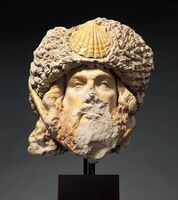 Head of Saint James the Greater
Head of Saint James the Greater The limestone carved head, once a part of a full statue, depicts St. James the Greater with his emblematic scallop shell on his pilgrim's hat. The statue provided pilgrims with the opportunity to pray before it on their journey to Compostela and receive encouragement and blessings from the saint on their journey.
-
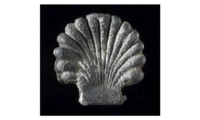 Scallop Pilgrim Badge
Scallop Pilgrim Badge The lead alloy badge is in the shape of a scallop shell, representative of the shell symbol of St. James. The small emblem symbolizes a token of the pilgrim as well as their accomplishment in partaking in the pilgrimage.
-
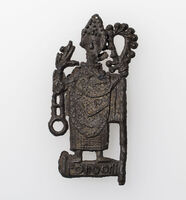 Pilgrim's Badge with Saint Leonard
Pilgrim's Badge with Saint Leonard The badge is a token of completion of the pilgrimage and acted as a type of souvenir sold to pilgrims. Made from lead alloy, the badge could be worn on the pilgrim's cloak. The figure holds his left hand up, with his middle and index figures pointing upwards and his thumb to the side, the hand gesture to indicate a blessing. He wears a pointed hat with beaded detail on the front of it. In his right hand, he holds a long curved staff. His mouth is open along with his eyes.
-
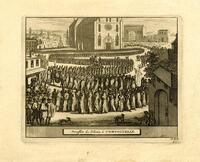 Procession des Pelerins a Compostelle
Procession des Pelerins a Compostelle The etching print depicts a procession of pilgrims in Compostela at the end of their pilgrimage to Santiago. There is a long snaking procession of pilgrims that stretch from the background with the cathedral Santiago de Compostela up through the middle ground to the foreground. They wear long pilgrims’ robes and march in a unison line. There are scattered spectators in the back right of the background and more densely grouped men in the left foreground corner, all wearing rounded hats. The tall cathedral extends beyond the top of the page and sits comfortably in the back center of the frame, providing the illusion of depth. A further back town in the left background corner also contributes to this effect. Overall, the drawing depicts the immensity of the amount of pilgrims and its popularity.
-
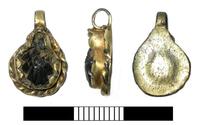 Pilgrim pear-shaped pendant
Pilgrim pear-shaped pendant The pendant is carved from jet and silver into a scallop shell shape in order to resemble to St. James pilgrim's emblems of the scallop shells. The object served as a souvenir for pilgrims after completing their pilgrimage to the shrine of Santiago de Compostela.
-
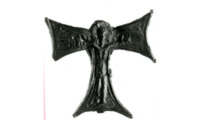 Pilgrim's Shell-Purse
Pilgrim's Shell-Purse The shell-purse was designed with a cavity to hold a cockle shell for a pilgrim on their journey Santiago de Compostela. It is cross-shaped with Christ on the front. The pilgrims would collect the shell at the cathedral in Santiago de Compostela at the shrine of St. James for proof of their completion of Camino de Santiago as well as an acting souvenir.
-
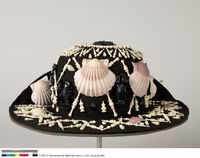 Pilgrim hat of Stephan III. Praun
Pilgrim hat of Stephan III. Praun The woolen hat was owned and used by Stephan Praun on his pilgrimage to Santiago de Compostela. The hat is densely decorated with a sewn in scallop shell, a miniature of St. James, and bones. The hat is shaped in the typical pilgrim's hat oblong shape, with a flat brim and tall head cavity. By wearing the hat, Praun would have been easily recognizable as a St. James pilgrim along with his staff, Bible, rosary, and long garment.
-
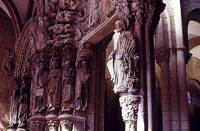 The Sculpture of the Pórtico de la Gloria, Santiago de Compostela
The Sculpture of the Pórtico de la Gloria, Santiago de Compostela The tall arched relief sculpture is the western entrance of the Cathedral of Santiago. On the facade and arch, there are jamb sculptures of St. James and New Testament, sculpted by Maestro Mateo in the 12th century and completed in the 13th century. In the Romanesque style, depicting the New Testament Apostles across from the Old Testament characters. With angels floating around the scenes, the figures fill the high wall with densely packed images.
-
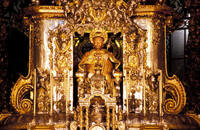 Altar at the Cathedral of St. James in Santiago de Compostela
Altar at the Cathedral of St. James in Santiago de Compostela The gilded altar is decorated with statues of St. James and cherubs. The entirety of the structure is wooden with golden coatings James in kingly robes and a monarch staff in his right hand. His head is adorned with a small crown and a crest on his chest. The altar is open in a manner that allows visitors and pilgrims to come behind and up a staircase to the altar so that they are able to touch the statue from the back. The altar was designed in the Baroque style, with the dense ornamentation of gold floral motifs and figures.
-
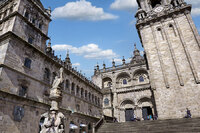 Santiago de Compostela Cathedral
Santiago de Compostela Cathedral The Romanesque Cathedral is the completion site in the city of Compostela Spain of the Way of St. James pilgrimage for pilgrims. Finished in 1211, the western exterior facades and interior designs incorporate Gothic and Baroque designs along with the main Romanesque. The Platerias Facade is the only remaining Romanesque facade. On the exterior lies Biblical stories in reliefs and in the interior an altar for St. James.
-
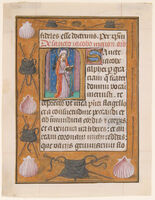 Manuscript Leaf with Saint James the Greater, from a Book of Hours
Manuscript Leaf with Saint James the Greater, from a Book of Hours The illustrated manuscript page depicts St. James the Greater as a medieval pilgrim with a walking stick and Bible in hand. The painted borders illustrate two crossed walking sticks behind a hand satchel followed by scallop shells that alternate with one another around the page. The words describe the life and works of St. James.
-
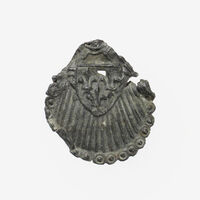 Pilgrim’s Badge
Pilgrim’s Badge A metalwork representation of a pilgrim’s scallop shell. With three French Fleur de Lis in a crest on the top of the shell, the badge ends in metal knobs. Worn as a symbol of pilgrimage, the metal badge represents an actual scallop shell that pilgrims also wore on their pilgrimages.
-
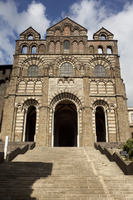 Cathedral Our Lady - Notre Dame du Puy-en-Velay
Cathedral Our Lady - Notre Dame du Puy-en-Velay This Romanesque cathedral which houses the Black Madonna, a replica created after the original’s destruction during the French Revolution, was and continues to be the starting place of the Way of St. James pilgrimage to Compostela in Spain. Composed of various architectural influences, Baroque, Muslim, Italian, and Byzantine, the cathedral sits at the top of a set of long stair with a tall flat western facade. Historically and presently, the cathedral is a place for pilgrims to seek refuge and inspiration for their journey and to receive blessings from the Madonna.
-
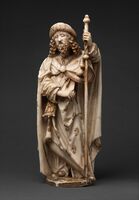 Saint James the Greater
Saint James the Greater The statuette of St. James is made of alabaster stone, gilded with gold, and delicately painted. St. James is depicted as a traditional medieval pilgrim with a scallop shell, traveler's hat, and staff. Since St. James is the patron saint of Spain, Queen Isabel of Castile commissioned the piece to appear with her in court.
 Devotional Badge with Saint James Flanked by Two Kneeling Pilgrims This green glass souvenir would have belonged to a pilgrim to take with them to remember their pilgrimage to Santiago de Compostela, Spain. There are two pilgrims kneeling next to St. James, also dressed as a pilgrim. The small green sculpture is made of smooth glass, is round in nature, and textured on the front. St. James has a beaded textured halo around his head as he holds the Bible in hand and looks straight ahead. The two kneeling pilgrims are identical on his sides and hold a walking staff, dressed in pilgrims clothing and hat. These figures sit on an even plane with each other and do not create any dimensions or foregrounds with this.
Devotional Badge with Saint James Flanked by Two Kneeling Pilgrims This green glass souvenir would have belonged to a pilgrim to take with them to remember their pilgrimage to Santiago de Compostela, Spain. There are two pilgrims kneeling next to St. James, also dressed as a pilgrim. The small green sculpture is made of smooth glass, is round in nature, and textured on the front. St. James has a beaded textured halo around his head as he holds the Bible in hand and looks straight ahead. The two kneeling pilgrims are identical on his sides and hold a walking staff, dressed in pilgrims clothing and hat. These figures sit on an even plane with each other and do not create any dimensions or foregrounds with this. Saint James the Greater The statue of St. James depicts him as a pilgrim, with a sympathetic face and outstretched right arm. He is missing his right hand but wears a pilgrim hat, decorated with an upside down scallop shell on the front, with a walking staff in his left hand, and long pilgrim garbs. The clothing folds and drapes into itself to suggest movement in the material and from the man. The front folds of his garbs are gold with, with blueish green on the back coat, and red wrist coffs. He looks up above the natural line of sight with his chin lifted and tilted slightly to the right side. With a small positive smile, his chin is adorned with a long brown curly beard and brown flowing hair on the side of his face, touching his shoulders.
Saint James the Greater The statue of St. James depicts him as a pilgrim, with a sympathetic face and outstretched right arm. He is missing his right hand but wears a pilgrim hat, decorated with an upside down scallop shell on the front, with a walking staff in his left hand, and long pilgrim garbs. The clothing folds and drapes into itself to suggest movement in the material and from the man. The front folds of his garbs are gold with, with blueish green on the back coat, and red wrist coffs. He looks up above the natural line of sight with his chin lifted and tilted slightly to the right side. With a small positive smile, his chin is adorned with a long brown curly beard and brown flowing hair on the side of his face, touching his shoulders. Puerta de las Platerias The southern façade of Santiago de Compostela, known as the Puerta de las Platerias was a common entrance into the cathedral by pilgrims. The design is Romanesque with stone rounded arches that are densely decorated with carved reliefs depicting Biblical characters and stories. The arch is called a tympanum with the round facade and relief worked into its exterior construction. The scene depicts the various duels of Jesus and Satan, where Jesus rebukes him. Angels and demons are scattered intermittently between the scenes, both represented with wings and some demons as monkeys. In entering the cathedral under these two tympanums, a pilgrim could learn about the struggle of good versus evil.
Puerta de las Platerias The southern façade of Santiago de Compostela, known as the Puerta de las Platerias was a common entrance into the cathedral by pilgrims. The design is Romanesque with stone rounded arches that are densely decorated with carved reliefs depicting Biblical characters and stories. The arch is called a tympanum with the round facade and relief worked into its exterior construction. The scene depicts the various duels of Jesus and Satan, where Jesus rebukes him. Angels and demons are scattered intermittently between the scenes, both represented with wings and some demons as monkeys. In entering the cathedral under these two tympanums, a pilgrim could learn about the struggle of good versus evil. Apostle Spoon: St. James The spoon's handle has a miniature of St. James, dressed as a pilgrim, with a large oblong pilgrim’s hat, robe, and walking staff. The small object served as a souvenir of completing the Camino de Santiago pilgrimage and a reminder of St. James himself.
Apostle Spoon: St. James The spoon's handle has a miniature of St. James, dressed as a pilgrim, with a large oblong pilgrim’s hat, robe, and walking staff. The small object served as a souvenir of completing the Camino de Santiago pilgrimage and a reminder of St. James himself. Leaf from a Book of Hours: Saint James the Greater The page in the Book of Hours depicts St. James as a traditional pilgrim with a staff and scallop shell pilgrim's hat. The manuscript illumination places St. James inside a landscape with a gold leaf and painted floral border. The Latin text adds detail and understanding to the page as well. Since there is an illuminated beginning letter, the “O”, painted with gold leaf and blue and red floral detailing inside of it, and a miniature of St. James, the page represents a title or chapter page for the next section.
Leaf from a Book of Hours: Saint James the Greater The page in the Book of Hours depicts St. James as a traditional pilgrim with a staff and scallop shell pilgrim's hat. The manuscript illumination places St. James inside a landscape with a gold leaf and painted floral border. The Latin text adds detail and understanding to the page as well. Since there is an illuminated beginning letter, the “O”, painted with gold leaf and blue and red floral detailing inside of it, and a miniature of St. James, the page represents a title or chapter page for the next section. Black Madonna The Black Madonna of Notre Dame du Puy is one of many "Vierges Noires" in France. It was believed to have been brought back from the Holy Land by St. Louis to France in the mid-13th century. Her presence, as brought forth in her statue, allowed for Catholics to pray to her instead of having to travel to the Holy Land in order to do so. The style is Romanesque and made of wood. She wears a tall golden crown on the top of her head with a long head dress underneath. She is also dressed in a long white robe, with gold and pink embroidery and embellishment details, that covers her entire body. The infant Christ child appears in the center of her robe, emerging from her womb.
Black Madonna The Black Madonna of Notre Dame du Puy is one of many "Vierges Noires" in France. It was believed to have been brought back from the Holy Land by St. Louis to France in the mid-13th century. Her presence, as brought forth in her statue, allowed for Catholics to pray to her instead of having to travel to the Holy Land in order to do so. The style is Romanesque and made of wood. She wears a tall golden crown on the top of her head with a long head dress underneath. She is also dressed in a long white robe, with gold and pink embroidery and embellishment details, that covers her entire body. The infant Christ child appears in the center of her robe, emerging from her womb. Head of Saint James the Greater The limestone carved head, once a part of a full statue, depicts St. James the Greater with his emblematic scallop shell on his pilgrim's hat. The statue provided pilgrims with the opportunity to pray before it on their journey to Compostela and receive encouragement and blessings from the saint on their journey.
Head of Saint James the Greater The limestone carved head, once a part of a full statue, depicts St. James the Greater with his emblematic scallop shell on his pilgrim's hat. The statue provided pilgrims with the opportunity to pray before it on their journey to Compostela and receive encouragement and blessings from the saint on their journey. Scallop Pilgrim Badge The lead alloy badge is in the shape of a scallop shell, representative of the shell symbol of St. James. The small emblem symbolizes a token of the pilgrim as well as their accomplishment in partaking in the pilgrimage.
Scallop Pilgrim Badge The lead alloy badge is in the shape of a scallop shell, representative of the shell symbol of St. James. The small emblem symbolizes a token of the pilgrim as well as their accomplishment in partaking in the pilgrimage. Pilgrim's Badge with Saint Leonard The badge is a token of completion of the pilgrimage and acted as a type of souvenir sold to pilgrims. Made from lead alloy, the badge could be worn on the pilgrim's cloak. The figure holds his left hand up, with his middle and index figures pointing upwards and his thumb to the side, the hand gesture to indicate a blessing. He wears a pointed hat with beaded detail on the front of it. In his right hand, he holds a long curved staff. His mouth is open along with his eyes.
Pilgrim's Badge with Saint Leonard The badge is a token of completion of the pilgrimage and acted as a type of souvenir sold to pilgrims. Made from lead alloy, the badge could be worn on the pilgrim's cloak. The figure holds his left hand up, with his middle and index figures pointing upwards and his thumb to the side, the hand gesture to indicate a blessing. He wears a pointed hat with beaded detail on the front of it. In his right hand, he holds a long curved staff. His mouth is open along with his eyes. Procession des Pelerins a Compostelle The etching print depicts a procession of pilgrims in Compostela at the end of their pilgrimage to Santiago. There is a long snaking procession of pilgrims that stretch from the background with the cathedral Santiago de Compostela up through the middle ground to the foreground. They wear long pilgrims’ robes and march in a unison line. There are scattered spectators in the back right of the background and more densely grouped men in the left foreground corner, all wearing rounded hats. The tall cathedral extends beyond the top of the page and sits comfortably in the back center of the frame, providing the illusion of depth. A further back town in the left background corner also contributes to this effect. Overall, the drawing depicts the immensity of the amount of pilgrims and its popularity.
Procession des Pelerins a Compostelle The etching print depicts a procession of pilgrims in Compostela at the end of their pilgrimage to Santiago. There is a long snaking procession of pilgrims that stretch from the background with the cathedral Santiago de Compostela up through the middle ground to the foreground. They wear long pilgrims’ robes and march in a unison line. There are scattered spectators in the back right of the background and more densely grouped men in the left foreground corner, all wearing rounded hats. The tall cathedral extends beyond the top of the page and sits comfortably in the back center of the frame, providing the illusion of depth. A further back town in the left background corner also contributes to this effect. Overall, the drawing depicts the immensity of the amount of pilgrims and its popularity. Pilgrim pear-shaped pendant The pendant is carved from jet and silver into a scallop shell shape in order to resemble to St. James pilgrim's emblems of the scallop shells. The object served as a souvenir for pilgrims after completing their pilgrimage to the shrine of Santiago de Compostela.
Pilgrim pear-shaped pendant The pendant is carved from jet and silver into a scallop shell shape in order to resemble to St. James pilgrim's emblems of the scallop shells. The object served as a souvenir for pilgrims after completing their pilgrimage to the shrine of Santiago de Compostela. Pilgrim's Shell-Purse The shell-purse was designed with a cavity to hold a cockle shell for a pilgrim on their journey Santiago de Compostela. It is cross-shaped with Christ on the front. The pilgrims would collect the shell at the cathedral in Santiago de Compostela at the shrine of St. James for proof of their completion of Camino de Santiago as well as an acting souvenir.
Pilgrim's Shell-Purse The shell-purse was designed with a cavity to hold a cockle shell for a pilgrim on their journey Santiago de Compostela. It is cross-shaped with Christ on the front. The pilgrims would collect the shell at the cathedral in Santiago de Compostela at the shrine of St. James for proof of their completion of Camino de Santiago as well as an acting souvenir. Pilgrim hat of Stephan III. Praun The woolen hat was owned and used by Stephan Praun on his pilgrimage to Santiago de Compostela. The hat is densely decorated with a sewn in scallop shell, a miniature of St. James, and bones. The hat is shaped in the typical pilgrim's hat oblong shape, with a flat brim and tall head cavity. By wearing the hat, Praun would have been easily recognizable as a St. James pilgrim along with his staff, Bible, rosary, and long garment.
Pilgrim hat of Stephan III. Praun The woolen hat was owned and used by Stephan Praun on his pilgrimage to Santiago de Compostela. The hat is densely decorated with a sewn in scallop shell, a miniature of St. James, and bones. The hat is shaped in the typical pilgrim's hat oblong shape, with a flat brim and tall head cavity. By wearing the hat, Praun would have been easily recognizable as a St. James pilgrim along with his staff, Bible, rosary, and long garment. The Sculpture of the Pórtico de la Gloria, Santiago de Compostela The tall arched relief sculpture is the western entrance of the Cathedral of Santiago. On the facade and arch, there are jamb sculptures of St. James and New Testament, sculpted by Maestro Mateo in the 12th century and completed in the 13th century. In the Romanesque style, depicting the New Testament Apostles across from the Old Testament characters. With angels floating around the scenes, the figures fill the high wall with densely packed images.
The Sculpture of the Pórtico de la Gloria, Santiago de Compostela The tall arched relief sculpture is the western entrance of the Cathedral of Santiago. On the facade and arch, there are jamb sculptures of St. James and New Testament, sculpted by Maestro Mateo in the 12th century and completed in the 13th century. In the Romanesque style, depicting the New Testament Apostles across from the Old Testament characters. With angels floating around the scenes, the figures fill the high wall with densely packed images. Altar at the Cathedral of St. James in Santiago de Compostela The gilded altar is decorated with statues of St. James and cherubs. The entirety of the structure is wooden with golden coatings James in kingly robes and a monarch staff in his right hand. His head is adorned with a small crown and a crest on his chest. The altar is open in a manner that allows visitors and pilgrims to come behind and up a staircase to the altar so that they are able to touch the statue from the back. The altar was designed in the Baroque style, with the dense ornamentation of gold floral motifs and figures.
Altar at the Cathedral of St. James in Santiago de Compostela The gilded altar is decorated with statues of St. James and cherubs. The entirety of the structure is wooden with golden coatings James in kingly robes and a monarch staff in his right hand. His head is adorned with a small crown and a crest on his chest. The altar is open in a manner that allows visitors and pilgrims to come behind and up a staircase to the altar so that they are able to touch the statue from the back. The altar was designed in the Baroque style, with the dense ornamentation of gold floral motifs and figures. Santiago de Compostela Cathedral The Romanesque Cathedral is the completion site in the city of Compostela Spain of the Way of St. James pilgrimage for pilgrims. Finished in 1211, the western exterior facades and interior designs incorporate Gothic and Baroque designs along with the main Romanesque. The Platerias Facade is the only remaining Romanesque facade. On the exterior lies Biblical stories in reliefs and in the interior an altar for St. James.
Santiago de Compostela Cathedral The Romanesque Cathedral is the completion site in the city of Compostela Spain of the Way of St. James pilgrimage for pilgrims. Finished in 1211, the western exterior facades and interior designs incorporate Gothic and Baroque designs along with the main Romanesque. The Platerias Facade is the only remaining Romanesque facade. On the exterior lies Biblical stories in reliefs and in the interior an altar for St. James. Manuscript Leaf with Saint James the Greater, from a Book of Hours The illustrated manuscript page depicts St. James the Greater as a medieval pilgrim with a walking stick and Bible in hand. The painted borders illustrate two crossed walking sticks behind a hand satchel followed by scallop shells that alternate with one another around the page. The words describe the life and works of St. James.
Manuscript Leaf with Saint James the Greater, from a Book of Hours The illustrated manuscript page depicts St. James the Greater as a medieval pilgrim with a walking stick and Bible in hand. The painted borders illustrate two crossed walking sticks behind a hand satchel followed by scallop shells that alternate with one another around the page. The words describe the life and works of St. James. Pilgrim’s Badge A metalwork representation of a pilgrim’s scallop shell. With three French Fleur de Lis in a crest on the top of the shell, the badge ends in metal knobs. Worn as a symbol of pilgrimage, the metal badge represents an actual scallop shell that pilgrims also wore on their pilgrimages.
Pilgrim’s Badge A metalwork representation of a pilgrim’s scallop shell. With three French Fleur de Lis in a crest on the top of the shell, the badge ends in metal knobs. Worn as a symbol of pilgrimage, the metal badge represents an actual scallop shell that pilgrims also wore on their pilgrimages. Cathedral Our Lady - Notre Dame du Puy-en-Velay This Romanesque cathedral which houses the Black Madonna, a replica created after the original’s destruction during the French Revolution, was and continues to be the starting place of the Way of St. James pilgrimage to Compostela in Spain. Composed of various architectural influences, Baroque, Muslim, Italian, and Byzantine, the cathedral sits at the top of a set of long stair with a tall flat western facade. Historically and presently, the cathedral is a place for pilgrims to seek refuge and inspiration for their journey and to receive blessings from the Madonna.
Cathedral Our Lady - Notre Dame du Puy-en-Velay This Romanesque cathedral which houses the Black Madonna, a replica created after the original’s destruction during the French Revolution, was and continues to be the starting place of the Way of St. James pilgrimage to Compostela in Spain. Composed of various architectural influences, Baroque, Muslim, Italian, and Byzantine, the cathedral sits at the top of a set of long stair with a tall flat western facade. Historically and presently, the cathedral is a place for pilgrims to seek refuge and inspiration for their journey and to receive blessings from the Madonna. Saint James the Greater The statuette of St. James is made of alabaster stone, gilded with gold, and delicately painted. St. James is depicted as a traditional medieval pilgrim with a scallop shell, traveler's hat, and staff. Since St. James is the patron saint of Spain, Queen Isabel of Castile commissioned the piece to appear with her in court.
Saint James the Greater The statuette of St. James is made of alabaster stone, gilded with gold, and delicately painted. St. James is depicted as a traditional medieval pilgrim with a scallop shell, traveler's hat, and staff. Since St. James is the patron saint of Spain, Queen Isabel of Castile commissioned the piece to appear with her in court.